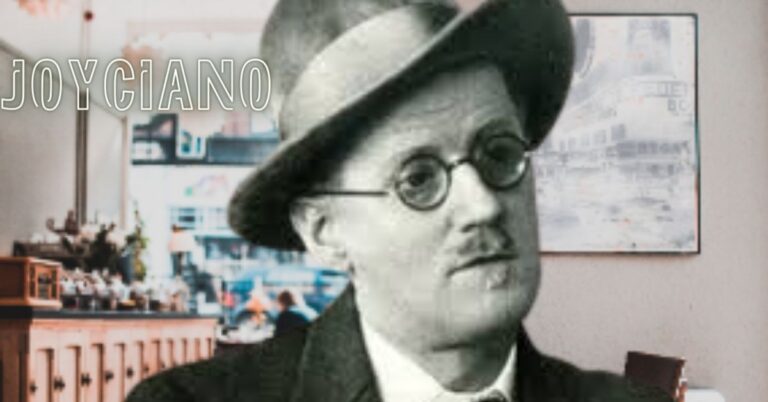Introduction to James Joyce and his literary works
Step into the enchanting world of James Joyce, where words dance on the pages like leaves in a gentle breeze. Join us on a journey through Dublin’s cobbled streets and delve into the profound depths of Joyciano literature. Discover how this literary genius continues to captivate readers worldwide with his unique storytelling and intricate symbolism. Are you ready to unlock the mysteries of Joyce’s works? Let’s embark on this literary adventure together!
The significance of
When delving into the world of James Joyce, one cannot overlook the profound significance of his literary contributions. Joyce’s works stand as pillars in the realm of modernist literature, pushing boundaries and challenging traditional narrative forms.
His writing transcends mere storytelling; it is a reflection of complex human experiences, emotions, and societal norms. The depth and intricacy with which Joyce crafts his characters and narratives invite readers to ponder existential questions and explore the depths of consciousness.
Joyce’s exploration of Dublin as a setting is not merely descriptive but symbolic. Dublin becomes a character itself in his works, mirroring the joys, struggles, and complexities of its inhabitants. This unique approach to setting elevates Joyce’s storytelling to a new level.
The themes and motifs woven throughout Joyce’s writings are rich with symbolism and layers of meaning. From identity crises to political unrest, every element in his work serves a purpose in unraveling intricate narratives that leave lasting impressions on readers.
In essence, the significance of James Joyce lies not only in his literary prowess but also in his ability to capture universal truths through nuanced storytelling techniques that continue to captivate audiences worldwide.
Exploring the enchanting world of Dublin in Joyce’s works
Dublin, the city that breathes life into James Joyce’s literary tapestry. As you wander through its cobbled streets, you can almost feel the echoes of his characters mingling with the bustling crowds. The Liffey River flows like a ribbon connecting past and present, mirroring the themes of time and memory in Joyce’s works.
Stop by Davy Byrnes Pub where Leopold Bloom savored his Gorgonzola sandwich in “Ulysses,” or stroll down Eccles Street to glimpse into Molly Bloom’s inner thoughts. Trinity College whispers secrets from “A Portrait of the Artist as a Young Man,” while Glasnevin Cemetery resonates with the ghosts of Dubliners past.
Joyce invites us to peel back layers of Dublin’s history, revealing both its beauty and its shadows. The city becomes a character itself – vibrant yet melancholic, teeming with contradictions just like Joyce’s prose.
Analyzing the themes and motifs in
Delving into the intricate web of themes and motifs woven by James Joyce is akin to embarking on a literary treasure hunt through the pages of his works. From the complexities of identity and self-discovery to the exploration of memory, time, and history, Joyce’s writing resonates with profound depth.
The interplay between artistry and reality in Joyce’s narratives challenges readers to question their perceptions of truth and existence. His unique use of stream-of-consciousness technique invites us to dive deep into the minds of his characters, unraveling layers of thoughts and emotions.
Symbolism dances across Joyce’s prose like whispers in a crowded room, inviting interpretation and introspection. Every word seems carefully chosen to convey multiple meanings, creating a tapestry rich in significance.
Through subtle nuances and intricate details, Joyce crafts worlds within worlds for readers to explore and interpret. The fluidity with which he blends past with present mirrors the complexities of human experience itself – fragmented yet interconnected.
In essence, analyzing the themes and motifs in Joycean literature opens doors to endless possibilities for reflection and discovery. Each reading unveils new insights that enrich our understanding not only of his work but also of ourselves as we navigate life’s intricacies alongside his characters.
The impact of Joyce’s writing on literature and society
James Joyce’s writing has had a profound impact on literature and society, shaping the way we perceive storytelling and language. His innovative narrative techniques have influenced countless authors, paving the way for modernist literature to flourish. By challenging traditional literary norms and experimenting with form, Joyce revolutionized the novel as an art form.
Joyce’s exploration of complex themes such as identity, memory, and human experience resonates deeply with readers across generations. His ability to capture the intricacies of everyday life in vivid detail adds depth and richness to his works. Through his masterful use of symbolism and stream-of-consciousness writing, Joyce invites us to delve into the depths of our own consciousness.
In dissecting societal norms and conventions, Joyce’s work forces readers to confront uncomfortable truths about power dynamics, cultural expectations, and individual freedom. His unflinching portrayal of Dublin society in particular sheds light on universal struggles that continue to reverberate today. As we navigate through Joyciano landscapes of thought-provoking narratives intertwined with social commentary, we are reminded of the enduring legacy that James Joyce has left behind for us all.
Uncovering hidden symbolism in
Delving into the world of Joyciano literary masterpieces unveils a treasure trove of hidden symbolism waiting to be discovered. From intricate wordplay to layered meanings, Joyce’s works are rich with symbols that add depth and complexity to his narratives.
One such example is the recurring motif of water in “Finnegans Wake,” symbolizing rebirth and renewal. The river Liffey flowing through Dublin represents the passage of time and life’s continuous journey. Through Joyce’s meticulous use of language and imagery, readers are invited to decode these subtle clues scattered throughout his texts.
In “Ulysses,” the symbolism of mirrors reflects themes of self-reflection and identity, mirroring characters’ inner struggles and external perceptions. The wandering protagonist, Leopold Bloom, embodies Odysseus on a modern odyssey through Dublin streets, encountering symbolic challenges along the way.
Joyciano intricate web of symbols invites readers to unravel the layers of meaning woven into his stories, creating a tapestry that rewards those who explore its depths with newfound insights and revelations.
Joycean tours and attractions in Dublin
Dublin, the city that inspired James Joyce’s masterpieces, offers a plethora of Joycean tours and attractions for literary enthusiasts. Embark on a guided stroll through the charming streets where Leopold Bloom wandered in “Ulysses.” Feel the essence of Dublin come alive as you visit key locations mentioned in Joyce’s works.
Experience a sensory overload at Sweny’s Pharmacy, where you can immerse yourself in the scents and sounds described by Joyce in his writing. Make your way to Davy Byrnes’ Pub, a famous landmark featured prominently in “Ulysses,” and savor a glass of wine just like Bloom did.
Don’t miss out on touring the James Joyce Centre to delve deeper into the life and works of this literary genius. Explore exhibitions dedicated to his legacy while gaining insights into his revolutionary writing style.
Engage with fellow Joyceans during walking tours or attend special events celebrating James Joyce’s contributions to literature. Experience Dublin through Joycean lens – an unforgettable journey awaits!
Conclusion
Why James Joyce continues to captivate readers and scholars alike is because his work transcends time and space. The depth of his writing, the complexity of his characters, and the richness of his themes continue to resonate with audiences around the world. Joyce’s ability to craft intricate narratives filled with hidden symbolism keeps readers coming back for more, uncovering new layers of meaning with each read.
As we delve into the enchanting world of Joyciano, we are not only exploring Dublin through Joyce’s eyes but also delving into the human experience in all its complexities. Through his works, Joyce challenges us to question our beliefs, confront our fears, and embrace the beauty of language itself.
In a world that is constantly evolving, James Joyce remains a timeless figure whose impact on literature and society endures. His legacy reminds us of the power of storytelling to illuminate truths about ourselves and the world around us. So let us continue to unravel the mysteries of Joyciano and be inspired by the enduring brilliance of James Joyce.
FAQs
1. What are James Joyce’s most famous works?
Joyciano is renowned for several key works that have made a significant impact on modernist literature. His most famous works include “Ulysses,” “A Portrait of the Artist as a Young Man,” “Dubliners,” and “Finnegans Wake.” Each of these works is celebrated for its innovative narrative techniques, rich symbolism, and deep exploration of human consciousness.
2. Why is “Ulysses” considered a groundbreaking novel?
“Ulysses” is considered groundbreaking due to its experimental narrative style and stream-of-consciousness technique, which delve deeply into the thoughts and experiences of its characters. The novel’s structure, paralleling Homer’s “Odyssey,” and its detailed depiction of a single day in Dublin, showcase Joyce’s ability to blend classical themes with modern life, pushing the boundaries of traditional storytelling.
3. How did James Joyce’s upbringing in Dublin influence his writing?
Joyciano upbringing in Dublin profoundly influenced his writing, as the city itself becomes a central character in many of his works. His intimate knowledge of Dublin’s streets, culture, and people provided a rich tapestry for his stories. Joyce’s detailed depiction of Dublin captures the essence of the city and its inhabitants, offering readers a vivid and authentic portrayal of early 20th-century Irish life.
4. What is the significance of stream-of-consciousness in Joyce’s works?
The stream-of-consciousness technique in Joyce’s works is significant as it allows readers to experience the inner thoughts and emotions of his characters in real-time. This narrative style breaks away from conventional linear storytelling, offering a more immersive and introspective reading experience. It reveals the complexity of human consciousness and the fluidity of thoughts, contributing to the depth and realism of his characters.
5. How has James Joyce influenced modern literature?
Joyciano has had a profound influence on modern literature through his innovative narrative techniques, complex character development, and exploration of universal themes. His works have inspired countless writers to experiment with form and style, leading to the development of new literary movements. Joyce’s emphasis on the intricacies of human thought and experience continues to resonate, making his contributions to literature timeless and influential.

